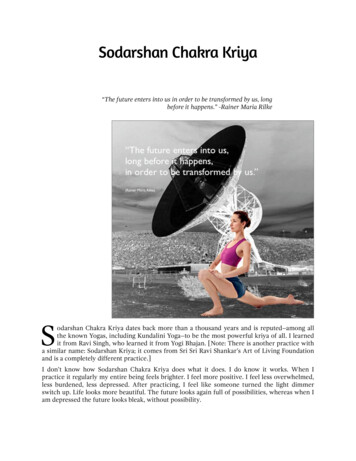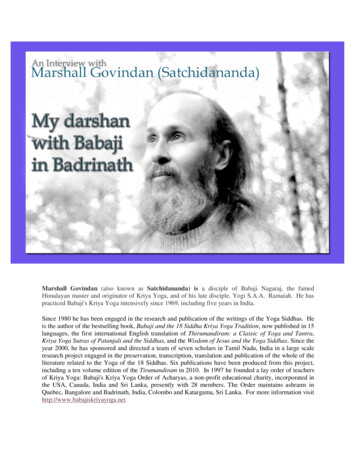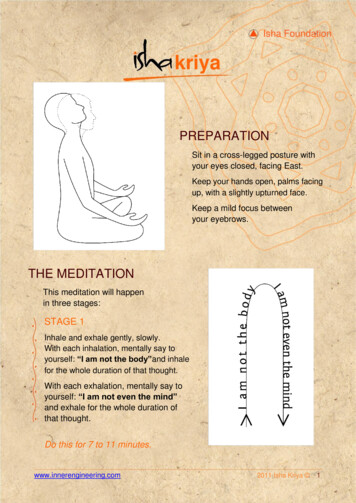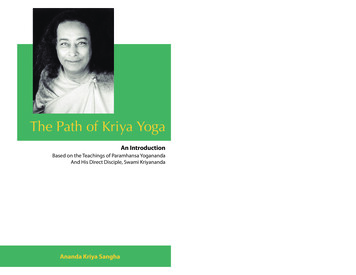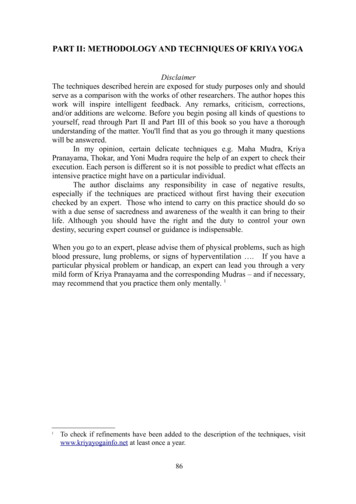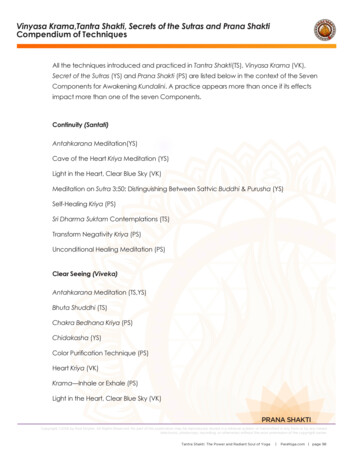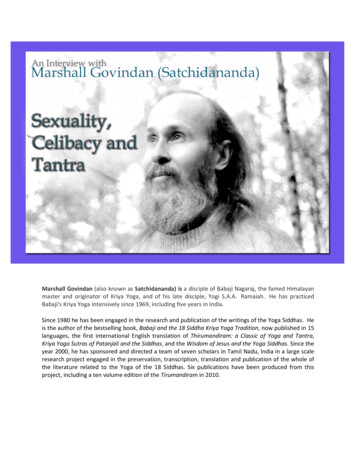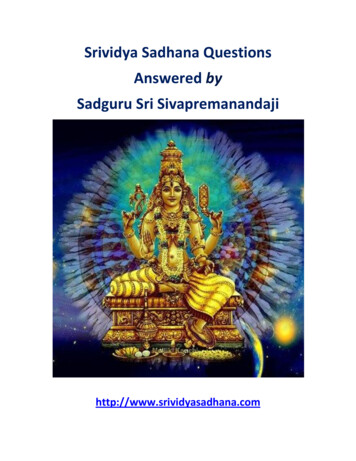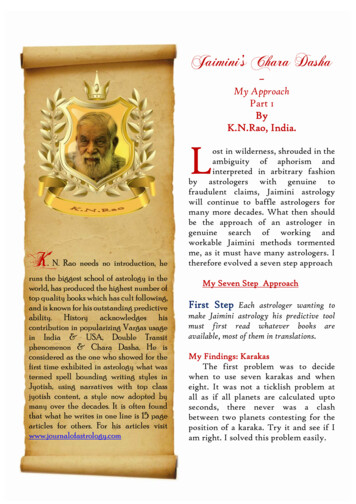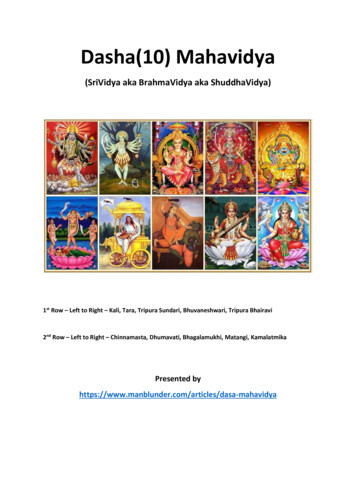
Transcription
Dasha(10) Mahavidya(SriVidya aka BrahmaVidya aka ShuddhaVidya)1st Row – Left to Right – Kali, Tara, Tripura Sundari, Bhuvaneshwari, Tripura Bhairavi2nd Row – Left to Right – Chinnamasta, Dhumavati, Bhagalamukhi, Matangi, KamalatmikaPresented ya
Position of Ten Mahā vidyā Devi’s In Our Body.1. Kālī – She controls both the biological heart and clairvoyant heart chakra. She also controlsblood.2. Tārā – She controls tongue. She is in total control of the final stage of speech paśyanti. Thisis how she is connected to knowledge. She controls navel chakra and her presence goes up toājñācakra.3. Tripurasundarī – She is at sahasrāra, the crown chakra.4. Bhuvaneśvari – She is the space in which the soul resides in heart chakra. According toKaṭha Upaniṣad, the Self resides in a cave in our heart. This cave is said to be space of ākāśa.5. Chinnamastā – She also controls ājñācakra and is in charge of upward movement of prāṇa.6. Tripurabhairavī – She is in mūlādhāra in the form of Kuṇḍalinī. It can be said that Kuṇḍalinīis also her name.7. Dhūmāvatī – She also resides in heart chakra. But her energy is powerful and at the sametime, it is always subtle. Negative thoughts and emotions emerge in the mind, when herenergy is hyperactive.8. Bagalāmukhī – She is in the upper palate, called Indra yoni (or Indra yoga) or the orifice ofIndra. This portion is extremely important as Divine nectar (cerebrospinal fluid) drips from theskull through this orifice. She is also related to heart chakra. She plays an important role intransmigration.9. Mātaṅgī – She presides over throat chakra (viśuddhi) and controls the delivery of speech.Hence she is treated on par with goddess Sarasvati, as she also controls Sarasvati nāḍi runningfrom ājñācakra to the tip of the tongue, conferring the abilities of foretelling.10. Kamalātmikā – She pervades in heart chakra and causes all sorts of auspiciousness andbeauty of the mind. She completely works on material world and fulfils all material desires.Only when the material desires are fulfilled, Self-realization can happen. Without realizing theSelf within, Liberation is not possible. Therefore, one’s fundamental spiritual quest is handledby her and she continues to stay till he/she crosses all materialistic desires. She affirms thatbody is the temple and soul within is the sanctum sanctorum.If we look at their placements in human body, all their function are related to higher chakras,except Tripurabhairavī, who is posited at mūlādhāra. These ten śakti-s work on subtle bodyand inculcate higher spiritual knowledge to realize Shiva.If we seriously look at these ten śakti-s, each of them control different activities and differentattributes or different aspects of mind and intellect. When they are depicted amorously, itsignifies deeper meaning of Shiva and Śakti union. Dhūmāvatī is depicted in a horrifyingmanner to convey the meaning that Shiva is not only good, but also equally bad. If Shiva isnot both good and bad, then He can never be called omnipresent. Shiva’s power is Śakti andShe manifests through various attributes in the form of these ten śakti-s. There is no questionof who is superior or inferior, as all the ten śakti-s are needed for our very existence. Each of
these śakti-s work on our subtle bodies to gain supreme knowledge leading realization ofShiva within and ultimately to become one with Shiva, the liberation.During the final stages of liberation, there will be no mantra and no more practices. Mantrascan help only to a certain extent, in the initial stages of spiritual life. Mantras are only toprotect the mind, not even to control the mind. The power of letters causes subtle vibrationsin the body which makes kuṇḍalinī ascend. When kuṇḍalinī is awakened, absorption beginsto unfold and during this stage, mantras percolate into our subconscious mind through manaschakra and there is no need for any mantra at this stage and beyond. When mantra ceases,meditation begins to happen on its own. When the meditation happens on its own, trance istriggered. One begins to realize the Self during high velocity trance. There is no need to sit forlong hours to meditate. One can remain in the highest stage of mediation for ten to twentyminutes. During the highest stages of meditation, ego is dissolved to almost nothingness; alldoubts are cleared (amalavijñāna). When ego is dissolved and mind is pure, one’sconsciousness becomes purer and purer over a period of time. The purest form ofConsciousness is Shiva.Introduction:This is one of the beautiful verses of Divine Mother which goes like this: “O! Bhavānī, sagesand saints describe Your gross forms. Vedas speak about Your subtle forms (mantra forms);some adore you as the origin of speech (Śabdrabrahman); some address you as the root ofworlds; but we think of You as Universal ocean of mercy and compassion and nothingelse”. This is how Śakti worship begins. Śiva is always Self-effulgent and hence He isaddressed as Prakāśa (Light) and Śakti is His Power to distribute His Light so that the universeis made visible. She is Vimarśa or cognizance. Light without cognizance and cognizancewithout light is of no use and based on this principle, Śiva and Śakti are always interdependentand also inherent (prakāśa vimarśa sāmarasyātmaka parabrahmasvarūpiṇi). In a humanbeing, Śiva exists as the Soul and Śakti exists as Māyā. Again as the Soul and Māyā, they areinseparable. However, the separation happens at the time of realization of the Self. Śaktimoves away revealing the True Nature of Śiva, who can be revealed only by Her. Towards thefinal stages of Self-realization, She becomes the Guru (Gurumūrtiḥ) to the aspirant andimparts the knowledge of Śiva (She is Śiva-jñāna-pradāyinī). Apart from the material gains,She is also worshiped for the purpose of realizing the Self (Śiva). Hence worshipping Śakti hasattained greater significance and is often called Śākta cult or Śākta tradition. Śakti has twoaspects; one is spiritual in nature and this is known as Cit-śakti (the Power of Consciousness)and the other is Māyā-śakti (the power of delusion) relating to the materialistic aspects of life.Then what is the difference between Śiva and Śakti? In reality, there is no difference and theyare so interdependent and the one without the other becomes inert. Śiva is static energy andHis own power Śakti (Svātantrya Śakti) is kinetic energy. They are also known as NirguṇaBrahman and Saguṇa Brahman and only after realising Saguṇa Brahman, one can merge intoNirguṇa Brahman, the purest form of Consciousness, Śiva. But for realising Śiva or mergingunto Him, we need Her stamp of approval. Main purpose of worshipping Her is to get HerGrace to merge unto Śiva (She is kaivalyapadadāyinī).
Most of Tantra Scriptures dwell on Consciousness and in fact they elucidate more practicaland realistic approach to God realization. Arthur Avlon said, “The Tantra has no notion ofsome separate far-seeing God. It preaches no such doctrine in it as that God; the Creator rulesthe Universe from heaven. In the eye of the Tantra, the body of sādhaka is the Universe”. Hefurther says that ātmaśakti within the body is what is sought for and it is the deity of thesādhaka, often called as Iṣṭa Devata. Unfolding of ātmaśakti is to be brought about by selfrealization or ātmadarśana, which is to be achieved through persistent practice, which isknown as sādhana. Ultimately understanding and realizing that the ātmaśakti and theSupreme Power or Śiva are one and the same and this ultimate knowledge completes one’sspiritual journey and at the end of which one is Liberated.Daśa Mahāvidyā-s are ten types of disciplines to reach the ultimate goal of one’s spiritual life.All the ten Mahāvidyā-s are also known as Brahma Vidyā. It is often misunderstood thatpursuing any of these Mahāvidyā-s lead to Liberation. It is a wrong notion. Every sādhanatakes forward the sādhaka towards the highest spiritual attainment viz. the liberation insuccessive stages. It is not that one gets liberated immediately on receipt of a mantra from aguru. Sādhana means leading straight to a goal (Liberation) and in the process bringing about,carrying out, accomplishing, fulfilling, completing, perfecting spiritual practices. Sādhana isnot merely ritualistic worship; it begins with ritualistic worship and over a period of timerealizing the fact, that the body is the temple and the Self within is the Sanctum Sanctorum.It is said that body is the temple and the jīvātman within the body is the Self. What is thedifference between Parmātman and jīvātman? Parmātman is nirmala or without impurities,no guṇa-s or attributes and in fact nothing except Purity. Jīvātman is that state of Parmātman,who is encased, veiled and covered by His own Power known as Māyā, which is full of spiritualignorance. Unless the veil of māyā is removed, Parmātman within cannot be realized. Theprocess of removing the veil of māyā is known as sādhana. What will happen when the veil ofmāyā is removed? There will be Ātmadarśana or realization of Śiva will happen which will leadto ultimate Liberation.Tantra śāstra-s attach more importance to Consciousness, which can be attained throughpuruṣārtha-s, the fourfold values of human life. They are dharma (righteousness or virtues),artha (wish or purpose), kāma (desires and pleasures) and mokṣa (the liberation). It is clearthat the ancient scriptures do not prohibit these great human values. What they say is not toget attached to them. On many occasions this concept is misquoted and misunderstood. Thefirst three of puruṣārtha-s are known as trivarga. Dharma is not bundle of Scriptural dictums,most of which are post Vedic origin. Dharma typically means the Law of Nature. We have togo with Nature or Prakṛti. In fact, the trivarga is controlled only by Nature. If any overdoing oroverindulgence is done, Nature interferes and stops further indulgence and this is known asLaw of Nature, which is controlled by Śakti. As long as the triads are within the Law of Nature,nothing will go wrong. This is what exactly Tantra śāstra-s advocate. According to Tantraśāstra-s, kāma means sensuality, the basis of which is Kāmasūtra of Vātsyāyana (4th century).In Kāmasūtra 64 types of postures are described and each of these postures has relation toeach of these 64 Tantra śāstra-s revealed by Śiva to Śakti. According to Tantra śāstra-sconjugation is also related to Consciousness. Tantra-s argue, when everything is Śiva, why setaside sex alone? Spiritual path cannot exist independently of the hedonic path; but thereshould be harmonious integration between the two; only then pinnacle of spirituality can beattained along with material comforts through rightful means. Absolute and perfectintegration should be there between material and spiritual life. Without body, how can we
work on our breath and mind to realize Śiva within? It is all about spontaneity in the life of atantric student. What is spontaneity? It is the quality of being spontaneous and coming fromnatural feelings without constraint. This is exactly what Tantra advocates. It is said, “To bespontaneous is to be Divine that goes beyond all notions of ego of separation. An actiondictated by the ego can never have the grace of true spontaneity.” But this sacred freedomshould not be confused with impulsiveness. Tantric aspirant does not have single unsatisfiedor hidden desires as he experiences everything through his tough sādhana. Repressions willnever take us forward in spiritual path as the mind wanders around the repressions only andwith this state of mind, divine spontaneity can never be achieved. But there are strict methodsthrough which such repressions are satisfied. Tantra accepts desire as the sole motivatingforce of the universe and does not advocate renunciation of desires. This is the significantdifference between Vedanta and Tantra.Most practices in Daśa Mahāvidyā-s fall under Tantric system. But the intensity of the systemvaries according to Guru Lineages. Some follow left hand path, some right hand path andsome use five M-s (pañcamakārat-s), etc. Daśa Mahāvidyā talks about ten forms of the sameGoddess Parāśakti (aparā, parā and parāparā), but with different qualities such as power,delight, beauty, wealth, etc. They are all Her various manifestations. True seekers arethreatened with dire consequences if something is done in a wrong way inadvertently; somegurus talk about secrecy which are nothing but their egocentrism. Nothing is secret inspirituality. How can there be secrets when She is omnipresent? While pursuing DaśaMahāvidyā-s, the first criterion is to shed their ego, which is the worst enemy to spiritualpursuit. Parāśakti is both Citśakti and Māyāśakti. First She is to be understood thoroughly andonly then one’s spiritual journey come to a logical conclusion.There are different views about the origin of Daśa Mahāvidyā-s, all relating to purāṇa-s. Oneof the stories goes like this. Śiva was very angry with His Consort Satī, as She decided to attenda Yajña conducted by Her father Dakṣa. After this, Śiva was not courting Satī and She got upsetand became terribly wrathful and this anger was reflected in Her eyes. As Śiva could not seeHer wrathful and red eyes, He closed His eyes and when He opened His eyes again, He saw awoman with blistering lustre. Śiva was so scared of Her form and started running away fromHer. To make sure that Śiva does not move away, She manifested in ten different forms (orShe created ten forms). When Śiva asked that woman who are they, She said that they areknown as Kālī, Tārā, Ṣoḍaśī, Bhuvaneśvarī, Chinnamastā, Tripurabhairavī, Dhūmavatī,Bagalāmukhī, Mātaṅgī and Kamalā. Śiva Purāṇa gives different version. What is importanthere is to note that all these worships lead only to Parāśakti, the source of all gods andgoddesses and their allocated powers and from Her proceeds everything else. She is theIndependent and Absolute Power of Paramaśiva and only through Her Grace, merging untoParamaśiva is possible to get liberated.With this brief introduction, this series will discuss about these Ten Mahāvidyā-s.
1. KĀLĪ कालीKāla means Śiva. It also means various factors of time including the time of departure (death).It also means black. If we take this to mean Śiva, then Kālī refers to His Consort Kālan-Kālī (likeBhairava and Bhairavi). If we take this to mean time, then Kālī is the Goddess to control thetime factor of the universe, as opposed to infinity of Śiva. The vastness of Śiva is bound byKālī, the Māyāśakti. She is Māyāśakti because of Her intrinsic darkness. Her incarnation isdescribed in Devi Bhāgavata Purāṇa (V chapter). The story goes like this. All gods andgoddesses prayed to Supreme Divine Mother Parāśakti to complain about two demonsŚumbha and Niśumbha, as they were persistently troubling gods and goddesses. Parāśakticreated a śakti from Her body and named her as Kauśika. Kauśika means the one having paws.According to Devi Bhāgavata, She is also known as Bhadrakālī (sometimes identified withDurga) and Kālarātrī (the night of all-destroying time, night of destruction at the end of theworld. Kālarātrī also refers to a particular night in the life of a man on the seventh day of theseventh month of the seventy-seventh year, after which period, a man is exempt fromattending to ordinances prescribed by dharma śāstra-s.)She is described in different forms. Her unique futures are Her black complexion and a garlandof skulls. She has four arms and in these four arms She holds a sickle in Her top left hand, achopped head in Her lower left hand, Regarding her right hands, description varies. In someof the descriptions, She is said to carry a cup containing blood and in the other hand Sheshows varada mudra (granting of boons). She is often described in Her standing posture on acorpse. Mahānirvāṇatantra describes Her with two hands, one with abhaya (removal of fearand contextually refers to fear from death) and another with varada (granting of boons)mudra. She is seated on a crimson coloured lotus. She has a protruding tongue, which signifiesthat She consumes all evil things and gives only the purest to Her devotees.Her complexion describes both death and infinity; death for the sinners and eternity is HerNature. She is beyond kāla (time), hence She is eternal. Garland made of skulls explains theentire beings of the universe. The entire creation is symbolically explained as skulls. Whyskull? Skull represents the reality of existence culminating into death, which is inevitable. Thegarland of skull is said to have 50 skulls, each representing 50 Sanskrit alphabets. She iswearing a skirt made of chopped hands, which represents destruction of karmas of those whohave surrendered unto Her. In a short of span of human existence, one’s ego plays animportant role. Unless one’s ego is destroyed, realization is not possible. When She is prayedin the right way, She removes one’s ego. This is symbolically expressed through the choppedhead. The sickle represents Her Grace and the chopped head represents one’s ego. When Sheshowers Her Grace, the first thing She does is to remove one’s ego. Why She chooses toannihilate our ego and what is the need? Tattvabodha explains ego as, “ahaṁkartāahaṁkāraḥ अहंकर्ाा अहंकारः” This means that the thought of doership is ego. Unless ego isdestroyed, spiritual journey cannot be pursued logically. She stands on a corpse and moreoften this corpse is depicted as Śiva, which subtly conveys without Śakti, Śiva is a corpse.Saundaryalaharī explains this concept thus. “Śiva becomes inert without Śaktī. When Śiva isnot united with Śaktī, He cannot manifest as the universe. Because of Her functional nature,Divine Mother becomes supremely important.” One important relationship other than beingMahākālā and Mahākālī is their abode; they live in crematorium and burial grounds. This is
mainly to convey that our ultimate destination is only the crematorium, irrespective of one’sstatus. That is why She is addressed as śmaśāna vāsinī (the one who dwells in crematoriums).Kālī Aṣṭotraṁ describes Her like this. She is the destroyer of time, terrible in form butbeneficent. She is the pride of Kali yuga, ocean of compassion without any limitation (becauseShe is Kālī), the One who liberates, destroyer of sins in Kali yuga. She is fond of virgins. Shehas soft and subtle voice, destroys fear and loves those who worship Her with musk. Her bodyis fully adored with camphor and sandal paste. She is an embodiment of kulācāra (also knownas kaulācāra), She is the queen of Benares, a holy city in India and destroys fears of those whoworship Her. She is adorned with a garland of bījākṣara klīṁ (kāmabīja). She is made up ofthree bījākṣara-s krīṁ hrīṁ śrīṁ** and She destroys death for those who recite thesebījākṣara-s.HER MANTRAS:There are several mantras for Her.1. Navakālī mantras mahākālasaṁhitā are published here2. Kāmakalākālī Trilokya Mohana Kavacham is published here.3. Her popularly known mantra is Dakṣiṇakālī mantra:ॐ क्ीं क्ीं क्ीं हं हं ह्ीं ह्ीं दक्षिणेकाक्षलके क्ीं क्ीं क्ीं हं हं ह्ीं ह्ीं स्वाहा॥om krīṁ krīṁ krīṁ hūṁ hūṁ hrīṁ hrīṁ dakṣiṇekālike krīṁ krīṁ krīṁ hūṁ hūṁ hrīṁ hrīṁsvāhā There are abbreviated versions of this mantra apart from other variations** क्ीं कल्याणी, ह्ीं काली, श्ीं कराली ॥krīṁ kalyāṇī (auspiciousness), hrīṁ kālī, śrīṁ karālī (karālī means dreadful)॥2. तारा TĀRĀTāra means saviour or protector; it also means shining, a mystical monosyllable like om.Often, Tārā is worshiped in both Buddhism and Jainism. There is a story associated with Herorigin. When the kṣīrasāgara (mythological ocean of milk) was churned, both nectar andpoison were obtained. Though all other gods and goddesses were afraid on seeing the deadlypoison, only Śiva remained unperturbed. Hence He is also known as Akṣobha (meaningunperturbed). Śiva consumed halāhala, the deadly poison. While He was consuming thispoison, Pārvatī, His Consort, held His throat to prevent poison percolating into His body. As aresult of this, halāhala was struck at His throat and it became blue in colour and hence Śiva isalso known as Nīlakaṇṭha (blue necked). The power of Śiva to remain as akṣobha comes fromTārā and the power of Śiva to consume halāhala comes from Pārvatī. This is how Tārā Devi isknown to us. She has few other forms like Ugra Tārā, Nīlā Sarasvati and Ekajaṭa. She is the
primordial sound (śabdabrahman) from which the speech originates. She controls one’semotions.She is Nāda and Śiva is Bindu.नाद क्षिन्दु * कलार्ी नमो नम। िेद मन्त्र स्वरूपा नमो नम॥nāda vindu* kalātī namo nama veda mantra svarūpā namo nama *bindu and vindu are the same.She appears more or less like Kālī, except the protruding tongue and the chopped head. Shealso holds a sickle and a scissor in Her left hand and a lotus flower and varada mudra in Herright hands. She is also wearing a garland made of skulls. She is standing on a corpse. It is saidthat attaining Her is much easier than other Goddesses of Daśa Mahāvidyā. There are norestrictions (niyama) to worship Her. She also represents om. According to some Scriptures,She belongs to uttarāmnāya.Number of benefits is enumerated if She is worshipped. Important of them are allaying fears,fear from wild animals, water and phantasms, attaining both material and spiritualknowledge. It is said that Tārā Kurukullā drives away evil spirits. She can never be approachedwith a specific way of worship. Visualising Her all the time is the best way to attain Her Grace.However, it is important that the one who practices Her mantra should never utter lies underany circumstances.HER DHYĀNA VERSES:The commonly known dhyāna verse describes Her as follows:1. “I meditate upon Tārā Devi with three eyes, adorned with white garments, whose lustre islike that of the moon, with crescent moon on Her head and who holds lotuses, a sickle and askull in Her hands.” This mantra gives all kinds of prosperity and attainments.There are other dhyāna verses which describes Her like this.2. She is seated on a swan with four faces and eight hands. She is clad in white dress. Sheholds a kamaṇḍalu (a vessel for holding water), a lotus, noose, another weapon called śakti,a rosary, a garland, varada and abhaya mudras. Meditating on this form is known as sṛṣṭi(creation) dhyāna.3. She is in Śvetadvīpa, known as White Island (a mythological island where liberated soulslive (they are frequently sent back to earth on various assignments; very close or similar toincarnations). She is with red garments and seated on a red throne. She has one face and fourhands. She holds a rosary, a cup filled with inebriant and varada and abhaya mudras.Meditating on this form is known as sthiti (maintenance) dhyāna.4. She is seated in a boat, in the middle of the ocean of blood, with black garments, wearingornaments made of bones. She has nine faces and 18 hands. She holds different powerfulweapons in Her 16 hands and varada and abhaya mudras in to hands. Meditating on this formis known as saṁhāra (destruction) dhyāna.
HER MANTRAS:This mantra gives all kinds of prosperity and attainments.1. ॐ ह्ीं त्ीं हं फट् ॥ om hrīṁ trīṁ huṁ phaṭ Sage Vasiṣṭha meditated the above mantra for a long time and She did not appear and hencehe cursed this mantra and after his curse the above mantra lost its potency. Soon after hisanger subsided, he removed his curse on the mantra by modifying trīṁ as strīṁ and thereafterthe mantra started yielding fruits. This mantra is thus modified and this modified mantraalone gives results.2. ॐ स्त्ीं ह्ीं हं फट् ॥ om strīṁ hrīṁ huṁ phaṭ 3. ॐ त्ीं ह्ां हं नमस्ताराय महार्ारायै सकल दु स्तरांस्तारय र्ाराय र्र र्र स्वाहा॥om trīṁ hrāṁ huṁ namastārāya mahātārāyai sakala dustarāṁstāraya tārāya tara tara svāhā Apart from the above mantras, there are eight mantras by which Brahmā and Viṣṇuworshiped Her.1. ॐ त्ीं ह्ीं हं फट् ॥ om trīṁ hrīṁ huṁ phaṭ 2. ॐ ऐं ह्ीं श्ीं क्ीं स ः हं उग्रर्ारे हं फट् ॥om aiṁ hrīṁ śrīṁ klīṁ sauḥ huṁ ugratāre huṁ phaṭ 3. ॐ हं ह्ीं क्ीं ह्स ः हं फट् ॥ om huṁ hrīṁ klīṁ hsauḥ huṁ phaṭ 4. ॐ ऐं ह्ीं श्ीं क्ीं ह्स ः हं उग्रर्रे हम् फट् ॥om aiṁ hrīṁ śrīṁ klīṁ hsauḥ huṁ ugratare hum phaṭ 5. ॐ हं ह्ीं क्ीं ह्स ः हं फट् ॥ om huṁ hrīṁ klīṁ hsauḥ huṁ phaṭ 6. ॐ ह्ीं हं ह्ीं हं फट् ॥ om hrīṁ huṁ hrīṁ huṁ phaṭ 7. ॐ त्ीं हं ह्ीं हं फट् ॥ om trīṁ huṁ hrīṁ huṁ phaṭ 8. ॐ त्ीं हं फट् क्ीं ऐं॥ om trīṁ huṁ phaṭ klīṁ aiṁ Ekajaṭā Mantra:1. ॐ ह्ीं स्त्ीं हं फट् ॥ om hrīṁ strīṁ huṁ phaṭ 2. ॐ ह्ीं नमो भगित्येकजटे मम िज्रपुष्पं प्रर्ीच्छ स्वाहा॥om hrīṁ namo bhagavatyekajaṭe mama vajrapuṣpaṁ pratīccha svāhā
Nīla Sarasvati Mantra:Form: She holds in Her left hands the bell and skull and in Her right hands, a trident and asword. She has crescent moon and She stands on a corpse. This mantra gives victories inarguments in court cases.1. ॐ श्ीं ह्ीं ह्स ः हं फट् नील सरस्वत्यै स्वाहा॥om śrīṁ hrīṁ hsauḥ huṁ phaṭ nīla sarasvatyai svāhā 2. ॐ ह्ीं स्त्ीं हं॥ om hrīṁ strīṁ huṁ Vidyārājñī Mantra:(This mantra bestows both material benefits and liberation).ॐ ऐं ह्ीं श्ीं क्ीं स ं क्ीं ह्ीं ऐं ब्लं स्त्ीं नीलर्ारे सरस्वक्षर् द्ां द्ीं क्ीं ब्लं सः ऐं ह्ीं श्ीं क्ीं स ः स ः ह्ीं स्वाहा॥om aiṁ hrīṁ śrīṁ klīṁ sauṁ klīṁ hrīṁ aiṁ blūṁ strīṁ nīlatāre sarasvati drāṁ drīṁ klīṁ blūṁsaḥ aiṁ hrīṁ śrīṁ klīṁ sauḥ sauḥ hrīṁ svāhā 3. क्षत्पुरसुन्दरी Tripura SundarīThis is the third of Mahāvidyā-s and is popularly known as Śrī Vidyā and the Goddessworshiped is known as Ṣoḍaśī. Śrī Vidyā is an ocean with different Guru Lineages. She is calledas Tripurasundarī because She rules all the three worlds. In Sanskrit, pura means a city ortown. Tripura means three cities or towns. Original reference about Tripura is in Śrī Rudraṁ,as an addition at the end first anuvāka. Śrī Rudraṁ says that Śiva is “tripurāntakāya” whichmeans three cities ruled by demons and antaka means causing death. This refers to a storywhere Śiva destroyed three cities ruled by three demons. His Consort is Tripurasundarī.Sundarī means beautiful.Lalitā Sahasranāma 626 is Tripurā, which is explained as below:“There is an ancient scripture titled Tripura rahasya in the form of dialogue between sageBhārgava and sage Dattatreya. The original text consists of three parts – The glory of Devi,Her rituals and knowledge about Her. This nāma could also mean that She is in the form ofall triads. For example, She is in the form of Brahma, Viṣṇu and Rudra; Icchā, jñāna and kriyāśakti-s; the three kūṭa-s of Pañcadaśī; creation, sustenance and destruction; the three nādis, iḍā, piṅgala and suṣumna; three worlds, bhūr, bhuva, suvaḥ; three guṇa-s sattvic, rajasicand tamsic. She is in the form of all such triads and once these triads are transcended, theBrahman is attained. Brahman is pure consciousness and can be visualized in three ways. Thefirst one is paramātṛ-caitanya (consciousness limited by intellect). The second one is pramāṇacaitanya (consciousness limited by knowledge). The third one is jīva-caitanya (consciousnesslimited by individual soul). These three types of consciousness are also known as triad.”There are many hymns in Her praise such as Lalitā Sahasranāma, Saundaryalaharī, etc. She isworshiped in Śri Cakra, which is considered as one the most auspicious yantra-s (mystical
diagram supposed to possess occult powers, if properly consecrated). She is worshiped in ŚriCakra through navāvaraṇa pūjā. Complete explanation of Śri Cakra and navāvaraṇa pūjā isavailable in this link Understanding and worshiping Śri Cakra. Tripurasundarī manifests indifferent shapes and forms such as Bālā Tripurasundarī, Lalitāmbikā, etc. Out of the tenMahāvidyā-s, Śrī Vidyā is considered as the most auspicious and powerful. Śiva is oftencompared to the sun and Tripurasundarī to moon. During full moon days, She is exactlyopposite to Śiva and when She prevails in the full moon, Her mantra form is Pañcadaśī. Duringnew moon days, She conjoins with Śiva and hands over Her sincere devotees to Him forLiberation. During new moon days, Her mantra form is Ṣoḍaśī. It is always better to repeatHer mantras during full moon days and new moon days.She is worshiped in Śri Cakra and all the gods and goddesses have a place either in Śri Cakraor in Śri Nagara, which is full of forts and forests. Journey through Śri Nagara towards Śri Cakrais explained in Journey to Śri Cakra. One is entitled to worship Śri Cakra only after properinitiation. Great importance is attached Guru in Śrī Vidyā. The ultimate aim of Śrī Vidyā is toconsider that there is no difference between Guru, the mantra initiated and Her. When thistriad dissolves in the mind of sādhaka, She reveals Herself to the sādhaka. From this pointonwards, She takes over the sādhaka as his Guru. But when She reveals Herself? This isexplained in Lalitā Sahasranāma 870 and 871, which are reproduced below.Antarmukha-samārādhyā ��या(870)She is worshipped by those who look within. She has to be realized by internal search andexploration. This is based on the theory that Ātman resides within.{Further reading: Kṛṣṇa explains the concept of looking within exhaustively in Bhagavad GītaChapter VI consisting of 47 verses and a gist of which is reproduced here as explained bySwami Chinmayananda. Karma yoga practiced without regard to the fruits of actions, form anexternal aid to better meditation. The process by which lower is brought under the directmanagement and discipline of the higher are all together called spiritual techniques. No Gurucan take the responsibility; no scripture can promise this redemption; no altar can, with itsdivine blessing make the lower the higher. The lower mist necessarily be trained slowly andsteadily to accept and under the influence of the discipline of the higher. When a seeker hascome in his life to the state explained as yogārūdāḥ, and when in that state of equipoise, themind is held steadfast in the contemplation of the Supreme, the self-controlled one, in allserenity is ca
nothing will go wrong. This is what exactly Tantra śāstra-s advocate. According to Tantra śāstra-s, kāma means sensuality, the basis of which is Kāmasūtra of Vātsyāyana (4th century). In Kāmasūtra 64 types of postures are described and each of these postures has relation to each of these 64 Tantra śāstra-s revealed by Śiva to Śakti.
